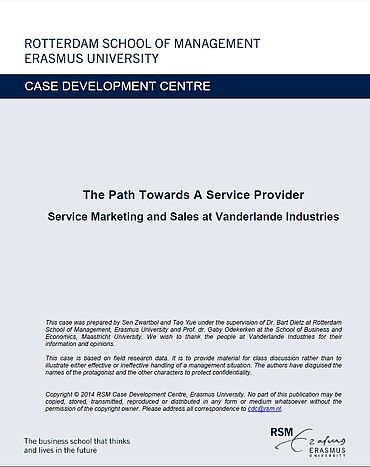Citation Note
Based on field research; 9 pages.
Follow the 'handle' link to access the Case Study on RePub.
For EUR staff members: the Teaching Note is available on request, you can contact us at rsm.nl/cdc/contact/
For external users: follow the link to purchase the Case Study and the Teaching Note.
description
The ambition of the seasoned manufacturing firm, Vanderlande Industries, was to commercialise services on a larger scale, with the aim of becoming a full-service provider. But the company had neither enough knowledge about its customers to make itself indispensible to their value chains, nor sufficient internal support on the work floor, to pull the transition off. How could Vanderlande prepare itself to catch the tailwinds towards further growth of its service business, without compromising its traditional business?
usage
This case provides unique material for understanding the differences between a service and a product company in marketing and sales.
Abstract
Vanderlande Industries (VI) is a Dutch multinational firm specializing in the manufacturing of goods handling systems. This case study deals with VI’s primary strategic route with regard to turning services into its core business. VI’s business proposition has evolved from manufacturing into product innovation and project management, and again into services during the first half of the 2000s. Services have grown rapidly since 2007 and have become the business segment with the highest growth rate in the company. In late 2013, VI expressed its ambition to commercialize services on a larger scale, with the goal of becoming a full-service provider. To achieve this, there were still two thresholds for the firm to cross: 1) VI still did not know enough about its customers to make itself indispensable to the value creation process, and 2) despite VI management’s ambition, not everyone in the organization believed they could pull it off. How could this seasoned manufacturing project firm prepare itself so it would not miss out on the headwind toward further growth of its service business without compromising its project business?
Objective
The main teaching objectives of this case are: 1. To understand the differences between a service and a product company in marketing and sales. 2. To understand the central role of customers in service innovation and sales. 3. To understand the role of knowledge in service sales. 4. To analyze internal and external marketing strategies to promote services. 5. To examine what is needed for organization and corporate culture to successfully transform from a product to a service firm.
